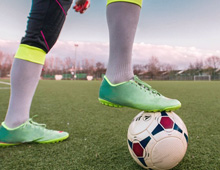The Science Behind How Compression Sleeves Work

" The Science Behind How Compression Sleeves Work
1. How Compression Sleeves Work: The Physics of Pressure
2. Circulation & Recovery: The Core Mechanisms
3. Health Benefits: From Pain Relief to Chronic Condition Support
4. Types of Compression Sleeves & Target Audiences
5. How to Choose the Right Compression Sleeves
6. Manufacturing Mastery: Designing for Efficacy and Customization
7. Conclusion
8. FAQs
Q1. What materials are used in your compression sleeves?
Q2. Can I customize compression sleeves with my brand logo?
Q3. What customization options are available for compression sleeves?
Q4. Can I create custom designs for specific markets or uses?
Q5. Can you provide compression sleeves with additional features like antibacterial or temperature-regulating fabrics?
In the dynamic realms of sports and rehabilitation, compression garments have become indispensable, merging scientific insight with practical utility. These snug-fitting accessories apply targeted pressure to specific body areas, enhancing blood flow and providing muscle support. This mechanism aids in reducing muscle oscillation, alleviating discomfort, and accelerating recovery. For instance, a study in the *British Journal of Sports Medicine* found that athletes using compression garments experienced notable reductions in post-exercise soreness, underscoring their effectiveness in recovery.
For brands and retailers, grasping the science behind these garments is crucial. It bridges the gap between consumer expectations and product performance, fostering trust and informed purchasing decisions. Understanding how compression wear functions empowers you to meet evolving consumer needs, ensuring your offerings align with their health and performance goals.
1. How Compression Sleeves Work: The Physics of Pressure
Materials Matter: The Key to Effective Compression Sleeves
The materials used in compression sleeves play a significant role in their effectiveness. Nylon and spandex are common choices, offering a balance of flexibility and support. These fabrics provide the right amount of stretch and durability to ensure consistent pressure on the muscles and joints. This pressure is crucial for enhancing circulation and muscle stability.
Graduated vs. Static Compression: The Role of mmHg in Performance
Not all compression is the same. Graduated compression sleeves are designed to apply more pressure at the ankle or wrist, gradually decreasing as they move up the limb. This design encourages better blood flow back to the heart. Static compression, on the other hand, applies even pressure throughout the sleeve. The level of pressure is measured in mmHg (millimeters of mercury), with higher values indicating stronger compression. For athletes and those recovering from injury, finding the right compression level can enhance performance and speed up recovery.
Stabilizing Muscles and Joints: Reducing Vibration and Fatigue
Compression sleeves help reduce muscle vibration during physical activity, which in turn lowers the risk of micro-tears. By providing support, they also help stabilize the muscles and joints, minimizing fatigue and strain. This is especially important for athletes, as it allows for longer periods of activity without overloading the body, promoting better endurance and reducing the likelihood of injury.

2. Circulation & Recovery: The Core Mechanisms
Accelerating Blood Flow: Oxygen Delivery and Waste Removal
One of the primary benefits of compression sleeves is their ability to improve circulation. By applying consistent pressure, they help increase blood flow, which enhances the delivery of oxygen to muscles and speeds up the removal of metabolic waste products. This process is vital for muscle recovery, as it helps reduce fatigue and supports the body’s natural healing processes.
Reducing Swelling and Thrombosis Risk: Clinical Proof for Vascular Health
Compression sleeves also play a key role in reducing swelling and the risk of deep vein thrombosis (DVT). Studies have shown that graduated compression can prevent blood from pooling in the limbs, which helps to minimize swelling and lower the risk of clot formation. This is particularly beneficial for athletes and individuals who spend long periods sitting or standing, as it supports vascular health and enhances overall circulation.
Post-Exercise Recovery: Combating DOMS and Inflammation
After intense physical activity, muscle soreness and inflammation are common, often leading to delayed onset muscle soreness (DOMS). Compression sleeves can help mitigate these effects by reducing inflammation and improving blood circulation. By speeding up the recovery process, they help athletes get back to their routines faster, reducing the downtime between workouts and preventing long-term fatigue.

3. Health Benefits: From Pain Relief to Chronic Condition Support
Addressing Muscle Fatigue: How Athletes Boost Endurance
Compression sleeves are great for athletes who want to reduce muscle fatigue and improve endurance. Research has shown that wearing these sleeves during exercise can help reduce muscle vibrations, leading to less fatigue and better performance. A study in the Journal of Strength and Conditioning found that athletes using compression garments experienced less soreness and recovered faster, allowing them to perform at their best for longer.
Medical Applications: Managing Lymphedema, Arthritis, and Post-Surgery Rehab
Compression sleeves also offer benefits for people with certain medical conditions. For example, they help manage lymphedema, which causes swelling, by promoting fluid movement. They can also provide relief for those with arthritis, helping to reduce joint pain and improve movement. Additionally, people recovering from surgery can use compression sleeves to reduce swelling and speed up recovery.
Everyday Wellness: Solutions for Desk Workers, Travelers, and Chronic Sufferers
Compression sleeves aren’t just for athletes or patients; they can be helpful for anyone who spends long hours sitting or standing. Desk workers and travelers can benefit from improved blood flow and reduced swelling in their legs and arms. People with poor circulation or chronic conditions can also use them to ease discomfort and support overall wellness, making them a practical addition to daily life.

4. Types of Compression Sleeves & Target Audiences
Arm Compression Sleeves: Ideal for Athletes and Injury Recovery
Arm compression sleeves are perfect for athletes, especially those who need extra support during intense activities. They’re also helpful for people recovering from arm injuries or surgery, as they promote blood circulation and reduce swelling. If your customers struggle with poor circulation in their arms, these sleeves can provide much-needed relief.
Leg Compression Sleeves: Great for Runners and Those Prone to Swelling
Leg compression sleeves are popular among runners and endurance athletes because they help reduce muscle fatigue and improve circulation. They’re also beneficial for people who experience leg swelling, whether from prolonged standing or traveling, making them an excellent choice for customers who are constantly on their feet.
Knee Compression Sleeves: Perfect for Joint Pain and Recovery
Knee compression sleeves are especially helpful for those with arthritis, tendonitis, or other knee issues. These sleeves provide stability and support, reducing pain and inflammation. They’re also beneficial for individuals recovering from knee surgery, offering extra comfort during the healing process.
Calf Compression Sleeves: Popular with Athletes and Long-Hour Workers
Calf compression sleeves are favored by athletes who need to improve circulation in their calves and reduce muscle strain. They’re also ideal for people who stand or walk for extended periods, such as healthcare workers, retail employees, and travelers, helping to prevent swelling and discomfort in the lower legs.
Ankle Compression Sleeves: Support for Recovery and Extra Stability
Ankle compression sleeves are designed for those recovering from ankle sprains or injuries. They provide stability and reduce swelling, helping customers regain mobility faster. These sleeves are also great for athletes or anyone who needs extra ankle support during physical activity, preventing further injury while enhancing performance.
5. How to Choose the Right Compression Sleeves
Understanding Different Compression Levels: Mild, Moderate, and Medical-Grade
When selecting compression sleeves, it’s important to understand the varying levels of pressure. Mild compression is suitable for everyday use and light activity, providing gentle support. Moderate compression offers more support and is ideal for athletes or individuals recovering from mild injuries. For more serious medical conditions, medical-grade compression is necessary, offering the highest level of pressure for targeted therapeutic benefits. Make sure to match the compression level to the specific needs of your customers.
Choosing Breathable, Sweat-Wicking, and Durable Materials
The materials of compression sleeves are crucial for comfort and effectiveness. Look for fabrics that are breathable and sweat-wicking, as these will keep the wearer cool and dry during use. Nylon, spandex, and polyester are commonly used because they offer the right balance of elasticity and durability. Ensure that the sleeves are long-lasting, as frequent use requires high-quality materials that can withstand wear and tear without losing their compressive qualities.
Ensuring the Proper Fit: Avoiding Restriction or Insufficient Support
Proper fit is essential when choosing compression sleeves. If the sleeves are too tight, they can restrict circulation, which defeats the purpose of using them. On the other hand, sleeves that are too loose won’t provide enough support. To ensure optimal effectiveness, guide your customers to select the right size based on their measurements. A well-fitting sleeve should feel snug but not uncomfortable, providing the right balance of compression and support.
6. Manufacturing Mastery: Designing Compression Sleeves for Precision and Customization
Fabric Engineering: The Art of Targeted Pressure
To maximize performance, compression sleeves rely on advanced textile blends like nylon-spandex or polyester-elastane hybrids. These materials balance elasticity with durability, ensuring consistent pressure (15-30 mmHg) without sacrificing comfort. Cutting-edge moisture-wicking fabrics keep users dry during intense workouts, while breathable mesh panels prevent overheating—a key feature for athletes and industrial workers. For medical-grade designs, antimicrobial coatings reduce infection risks, crucial for post-surgery or chronic condition management.
Seamless vs. Reinforced Stitching: Matching Design to Demand
Sports-focused compression sleeves often use flatlock stitching for rugged durability, ideal for repetitive motions in basketball or weightlifting. In contrast, seamless knitting caters to rehabilitation and fashion markets, offering irritation-free wear for sensitive skin. For industrial use, reflective strips or abrasion-resistant layers add functionality—enhancing safety for nighttime construction workers or factory staff.
Custom OEM Solutions: Meeting Unique Market Needs
Your customers have diverse needs—from marathon runners needing lightweight, breathable sleeves to office workers seeking discreet designs for all-day comfort. By collaborating with OEM experts, you can add specialized features like UV-protective fabrics for outdoor athletes or antibacterial coatings for medical use, ensuring your products solve specific problems.
For example, reflective strips on sleeves improve safety for nighttime construction workers, while eco-friendly materials like recycled polyester appeal to environmentally-conscious buyers.
7. Conclusion: Boost Your Brand with Custom Compression Sleeves
Compression sleeves offer great benefits, from improving circulation to helping with muscle recovery. Understanding how they work can help you meet your customers’ needs, whether they’re athletes, people recovering from injuries, or anyone looking for extra support.
Now is the perfect time to partner with a trusted manufacturer to provide high-quality, custom compression sleeves. If you’re ready to enhance your product offerings and give your customers the best, get in touch with us today. Let’s create the perfect solution for your brand!
8. FAQs
Q1: What materials are used in your compression sleeves?
Our compression sleeves are made from high-quality, durable materials like nylon and spandex. These fabrics are engineered for flexibility, comfort, and long-lasting support, ensuring both performance and durability.
Q2: Can I customize compression sleeves with my brand logo?
Yes, we offer customization options where you can add your brand logo, design, and colors to the compression sleeves, making them unique to your brand.
Q3: What customization options are available for compression sleeves?
You can customize the color, logo, size, and packaging of the compression sleeves. We also offer different compression levels and material choices to suit specific needs.
Q4: Can I create custom designs for specific markets or uses?
Absolutely! We work with you to design compression sleeves tailored for your target market, whether it’s for sports, medical use, or general wellness.
Q5: Can you provide compression sleeves with additional features like antibacterial or temperature-regulating fabrics?
Yes, we offer special customization options like antibacterial or temperature-regulating fabrics to meet specific needs for your customers.











